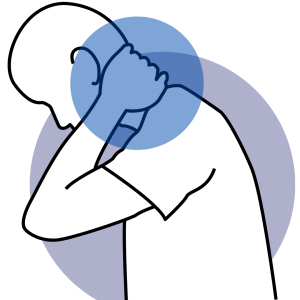
CALCIFICATION IN THE NECK
Osteoarthritis of the neck, also known as cervical osteoarthritis, is a condition caused by wear and degeneration of the cartilage in the joints between the vertebrae. This can cause pain, stiffness and restriction of movement in the neck area.
CAUSES
Aging:
Cartilage tissue can wear down over time and cause arthritis during the aging process.
Genetic Factors:
In people with a family history of osteoarthritis, genetic factors are thought to play a role in the development of osteoarthritis in the neck.
Trauma and Injuries:
A traumatic blow to the neck or accidental injuries can predispose to calcification.
Bad Posture Habits:
Long-term poor posture habits can trigger arthritis by putting extra pressure on the joints and cartilage tissues in the neck.
Rheumatic Diseases:
Some rheumatic diseases, especially rheumatoid arthritis, can affect the joints in the neck and lead to arthritis.
Overuse:
Overuse, repetitive movements or weight bearing can wear out the joints in the neck and lead to arthritis.
SYMPTOMS
Pain and stiffness:
Pain in the neck area and a feeling of stiffness, more pronounced in the morning.
Movement Restriction:
Difficulty and limitation in neck movements.
Headache:
Neck arthritis can cause headaches and tension headaches.
Shoulder and Arm Pain:
Osteoarthritis can cause pain starting from the shoulders and radiating into the arms.
Numbness and Tingling:
Numbness or tingling sensation in the hands and fingers due to pressure on the nerve roots.
NON-SURGICAL TREATMENT METHODS FOR CERVICAL OSTEOARTHRITIS
Medication Therapy:
Nonsteroidal anti-inflammatory drugs (NSAIDs) for pain and inflammation control.
Physical Therapy:
Physical therapy to strengthen the muscles in the neck, increase flexibility and correct posture.
Hot and Cold Application:
Relieve pain and stiffness with hot or cold compresses.
Exercise Programs:
Strengthening neck muscles and increasing flexibility with special exercise programs.
SURGICAL TREATMENT METHODS IN NECK CANCER
Surgical treatments for arthritis in the neck (cervical osteoarthritis) are usually considered when other treatment options have failed or the patient’s symptoms are severe.
Anterior Cervical Discectomy and Fusion (ACDF):
In this procedure, an anterior approach is used to remove the calcified disc and fuse the vertebrae together. Once the calcified disc has been removed, the vertebrae are fused together, usually using a graft or implant. This involves creating fused vertebrae instead of a disc.
Posterior Cervical Discectomy:
In this surgical method, the surgeon makes an incision at the back of the vertebrae and removes the calcified disc. This procedure is often used for conditions that put pressure on the nerve roots.
Cervical Foraminotomy:
In this procedure, the surgeon enlarges the foraminal area behind the cervical vertebrae, releasing the parts that can put pressure on the nerve roots. This allows the nerve roots to find more space.
Cervical Laminectomy:
Laminectomy involves partial or complete removal of the bony structures at the back of the vertebrae, called laminae. This can be done to provide more space for the spinal cord or nerve roots.
Artificial Disc Replacement:
In this procedure, instead of removing the calcified disc, an artificial disc is inserted. This can help maintain the mobility of the spine and there is no need to create fused vertebrae.
Fusion-Free Artificial Disc Replacement:
In this method, an artificial disc is inserted in place of the disc, but the vertebrae are not fused together. This preserves the mobility of the spine while at the same time providing a similar function to the disc replacement.
Every surgical intervention involves risks, so surgical options should be carefully considered. Rehabilitation and physical therapy after surgery is usually recommended to support recovery. It is important to consult a specialist to determine which surgical method is appropriate.




.png)
.png)
.png)